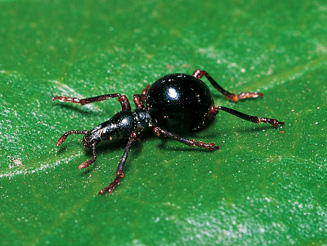Family:
Brentidae (primitive weevils, cycad weevils)
Life >
Eukaryotes >
Opisthokonta >
Metazoa (animals) > Bilateria > Ecdysozoa > Panarthropoda > Tritocerebra >
Arthopoda > Mandibulata > Atelocerata > Panhexapoda >
Hexapoda
> Insecta
(insects) > Dicondyla > Pterygota > Metapterygota > Neoptera > Eumetabola >
Holometabola > Coleoptera
(beetles)
> Polyphaga > Curculionoidea
Small to medium sized (4-20mm,
excluding extended snouts) with narrow, parallel-sided bodies. The heads are
slender and constricted at the back to form a neck.The females drill holes in
wood and with Antliarhinus, into cycad seeds. The mandibles (jaws) are
situated at the end of the rostrum (snout). With Antliarhinus, the
rostrum can be 3 times the length of the body while the male rostrum is shorter.
In some species, males have broad rostra with strong mandibles, that are
reported to be used to carry females prior to mating.
Once the holes are drilled, the females lay their eggs
inside and the larvae feed on wood or fungi in the holes. Adults feed on
fungi, sap or wood-eating insects.
|
 |
|
|
Cylas sp. 6-8mm. This genus includes the sweetpotato
weevils, including Cylas puncticollis, Cylas brunneus andCylas formicarius.
[image by M. Picker & C.
Griffiths ©, from Field Guide to Insects of South Africa,
used with permission]. |
|
Page by Margie Cochrane |
